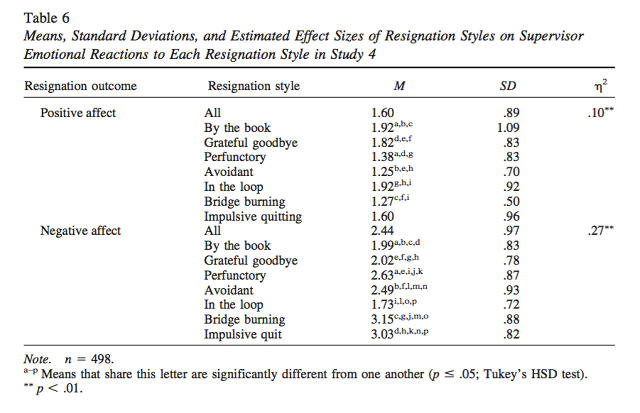Take This Job And Shove It, Say The Majority Of Employees Who Quit
Whether you give your employer appropriate notice and thank them for their leadership, or quit in a rage never to be heard from again, the way in which you choose to resign can reveal a lot about you, your employer, and the work environment.
While much has been written about when someone should quit their job, why someone should quit their job, and even the socially acceptable etiquette for quitting, there has been very little research into how people actually went about resigning, at least not until now.
Anthony Klotz, an assistant professor in the College of Business at Oregon State University, studies the ways people leave their jobs. He recently found that the way that as many as 48.9% of employees quit their jobs was received positively by employers, but the majority was not. Another 36.2% quit in a way that was perceived as negative, but not necessarily damaging to the employer, and 14.9% chose to resign using a method that could potentially inflict damage.
“For much of employees’ work lives, they possess relatively little power and control over their situation at work. However, once employees decide to leave, that power balance shifts,” Klotz says. “As such, the resignation is one of the few times that employees are free to express themselves without fearing termination,” he adds, suggesting that employers consider the way in which employees resign as a “diagnostic tool” for measuring employee satisfaction.

The study, which was recently published in the Journal of Applied Psychology, was conducted in four parts. The first two interviewed 53 MBA students who had recently quit their jobs and 202 supervisors who had overseen a resignation within the previous three months. The third study asked 240 former employees how their thoughts and feelings toward their former employer informed their decision on how to resign, and the final study of nearly 500 managers explored how they responded to various resignation styles and scenarios.
In his initial studies Klotz found that there were seven common ways in which people resign, listed in order of their frequency:
By the book (31%). These resignations involve a face-to-face meeting with one’s manager to announce the resignation, a standard notice period, and an explanation of the reason for quitting.
Perfunctory (23.5%). These resignations are similar to “by the book” resignations, except the meeting tends to be shorter and the reason for quitting is not provided.
Avoidant (12.7%). This occurs when employees let other employees such as peers, mentors, or human resources representatives know that they plan to leave rather than giving notice to their immediate boss.
Grateful goodbye (10%). Employees express gratitude toward their employer and often offer to help with the transition period.
Bridge burning (8.6%). In this resignation style, employees seek to harm the organization or its members on their way out the door, often with verbal assaults.
In the loop (7.9%). In these resignations, employees typically confide in their manager that they are contemplating quitting, or are looking for another job, before formally resigning.
Impulsive quitting (6.3%). Some employees simply walk off the job, never to return or communicate with their employer again. This can leave the organization in quite a lurch, given it is the only style in which no notice is provided.
Klotz explains that while the perfunctory and avoidant methods still allow the organization to fill a talent gap, managers generally view it as negative method of resignation, as they are kept in the dark about the employee’s reasons for quitting. In total, less than half of all employees quit in a manner that is viewed positively by managers, while more than 51% choose a method that is perceived as negative.

Unsurprisingly, Klotz found that workers who felt their employer had treated them fairly were more likely to resign in a positive way, while those who reported having a negative experience were more likely to choose a harsher resignation style.
“If they see a rash of negative resignations, it is a signal that employees are being treated poorly, and they should investigate and find the cause,” he says. However, Klotz notes, “When a company notices that in general their employees leave in a positive and grateful manner, they can take that as one sign that employees feel like they are treated relatively well.”
In his previous roles as both a manager and an employee, Klotz admits it was difficult to determine how best to resign, or how to feel about those who submitted their resignation to him. “I couldn’t discuss it with many people because I wanted it to remain confidential,” he says. This understandable lack of transparency around resigning can often lead to confusion on how to choose the appropriate method.
Klotz encourages managers and HR professionals to investigate how their employees chose their method of resignation, and what it says about the organization as a whole. In his own research Klotz found that management is quick to chalk up a negative departure to a bad apple, but it’s rarely that simple. He says, “What our results suggest is that employees who resign in these negative ways often do so in response to being treated unfairly by their organization or being abused by their supervisor.”
Fast Company , Read Full Story
(28)


